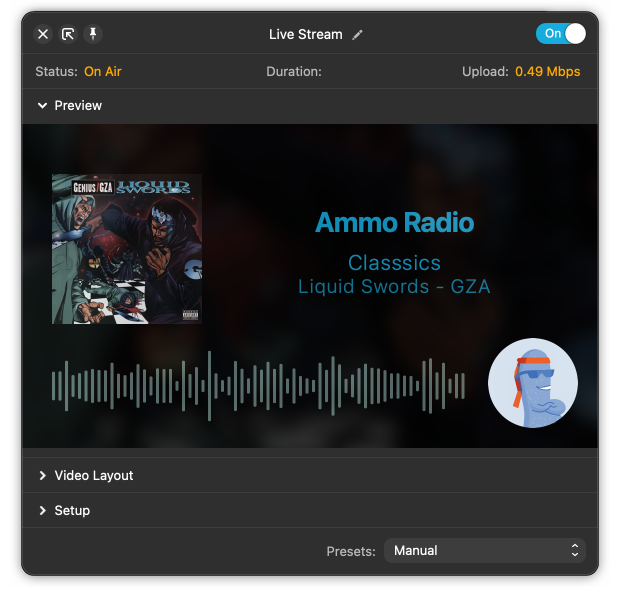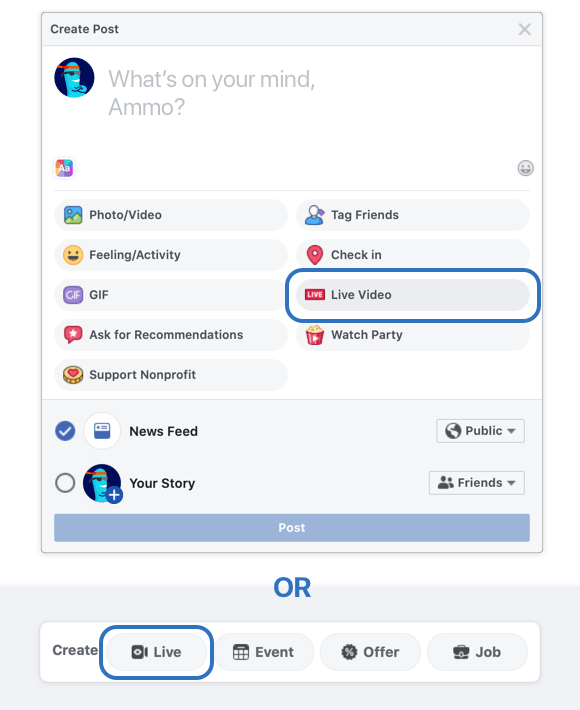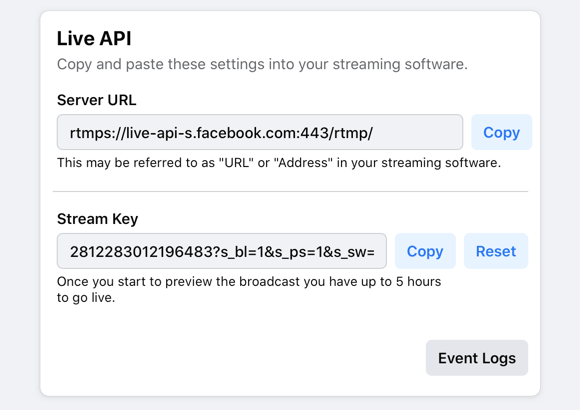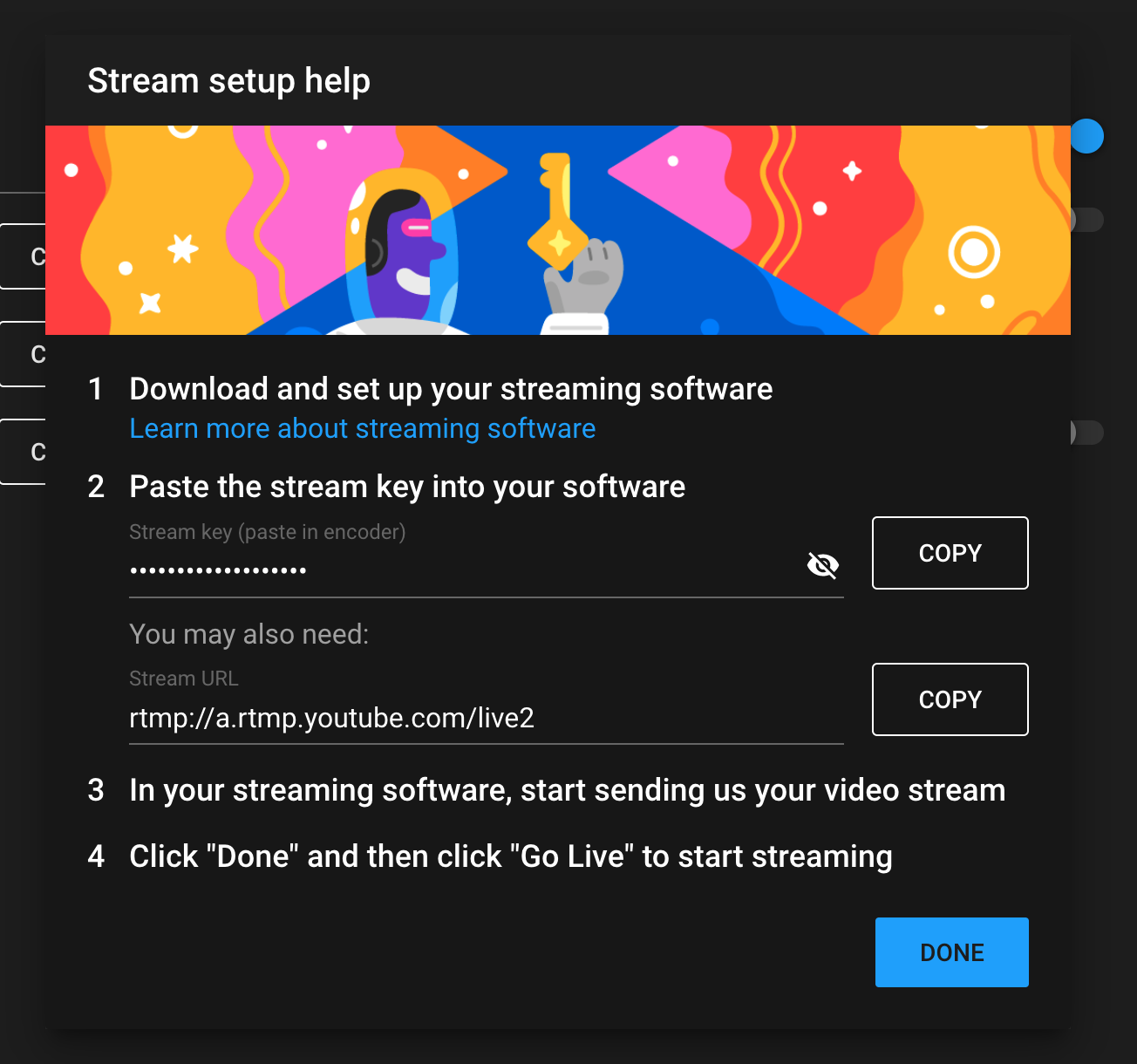Copyright © Rogue Amoeba Software, Inc. All rights reserved.
The Live Stream block was introduced in Audio Hijack 3.7. With Live Stream, you can transmit content to RTMP-based services, allowing listeners to tune in from around the globe.

The Live Stream block makes it a snap to offer a live feed of anything you like, whether that's recording a podcast, putting on live events like concerts and DJ sets, or anything else. To get started, just add a Live Stream block to your Session, then configure it to to an external server.
Be sure to see the “Live Stream Block” page of the Audio Hijack manual (found in the app's Help menu) for more details.
RTMP is most commonly used to stream video content. However, the Live Stream block is focused on transmitting audio feeds. When transmitting with Live Stream, Audio Hijack will automatically create supplemental video for your streams.

The Live Stream Block page of the Audio Hijack manual provides a detailed explanation of how this video is created.
The Live Stream block can embed metadata into your stream, to be shown to listeners when they tune in. For more details on metadata and Audio Hijack, please see “Showing metadata when streaming with Audio Hijack”.
The Live Stream block transmits to RTMP-based services, and there are many free services available to help you stream. Configuration instructions to assist with streaming to popular services are included at the end of this article.
Below, you'll find detailed instructions for configuring the Live Stream block to stream to several popular servers. If your desired service is not listed, you should just need to locate the Server URL, and Key, then enter them into the Setup section of the Live Stream block.
Jump to instructions for:
↓ Facebook Live
↓ Twitch
↓ YouTube Live
To begin, sign up for a Facebook account, if you don't already have one.
Access Facebook's Live Producer by starting a new Facebook post. For a standard user, click the ... button under Create Post, then select Live Video. If you'll be streaming from a Facebook Page, click Live in the Create section.

You should now be on the Live Producer screen. At the top, select Use Stream Key:


Click the Copy button next to Server URL, then paste that into the Live Stream block's Server URL field.
Back on the Live Producer screen, click the Copy button next to Stream Key field, then paste that into the Live Stream block's Key field.
Your Setup area should now look something like this:

You're now ready to go. When you begin transmitting in Audio Hijack, your stream should immediately be live on Facebook.
To begin, sign up for a Twitch account, if you don't already have one.
Visit https://stream.twitch.tv/ingests/, and copy the URL for a nearby “Ingest Endpoint”.
Paste the copied URL into the Live Stream block's Server URL field. Delete the “{stream_key}” text from the end, so it looks something like this:

Next, make sure you're logged in to Twitch, then click the user menu (showing your avatar) in the upper right, and click Creator Dashboard.
On the Creator Dashboard screen, click the More menu (three horizontal lines) in the upper left, then click Preferences, and finally, click Channel.
At the top of this screen, you should see a Primary Stream key field. Click the Copy button next to this.
Paste the copied stream key into the Live Stream block's Key field. The Setup area should now look like this:

You're now ready to go. When you begin transmitting in Audio Hijack, your stream should immediately be live. From Twitch's Creator Dashboard, click the Manage Stream for more.
To begin, create a YouTube channel, if you don't already have one. After that, follow Google's instructions to verify the channel and enable Live Streaming.
Visit your Channel dashboard at studio.youtube.com.
Create a new stream by clicking the Create button in the upper right, then selecting Go live.
Adjust the settings as you like, then click Create Stream.
You should next be shown a Stream setup help screen. You'll want to copy both the Stream key and the Server URL, and enter them into the Setup area of the Live Stream block.

You can now begin transmitting in Audio Hijack. Once you do, YouTube's page should indicate it's receiving your stream. You'll need to click the Go Live button to make your stream available to the world.